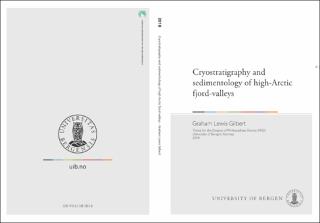Cryostratigraphy and sedimentology of high-Arctic fjord-valleys
Doctoral thesis
Permanent lenke
https://hdl.handle.net/1956/17627Utgivelsesdato
2018-01-17Metadata
Vis full innførselSamlinger
- Department of Earth Science [1040]
Sammendrag
Fjord-valleys, as sediment-filled palaeofjords, are characteristic of formerly glaciated mountainous coastal areas. High-Arctic fjord-valleys commonly host permafrost, but are poorly accessible and hence have drawn relatively little research. The research presented in this thesis combines the methods of cryostratigraphy, clastic sedimentology, sequence stratigraphy, geomorphology and geochronology to investigate the sedimentary infilling, permafrost formation and late Quaternary landscape development in two classical high- Arctic fjord-valleys: the Zackenberg in northeast Greenland (74°30’N, 20°30’W) and the Adventdalen in central Svalbard (78°12’N, 15°49’E). The study involves analysis of a unique set of drilling cores from boreholes 20 m to 60 m deep. Novel research aspects include introduction of the concept of cryofacies and an analysis of the relationship between cryofacies and lithofacies. The existing model for fjord-valley sequence stratigraphy is improved, and the geomorphic response of these landscapes to permafrost degradation is considered in connection with the impending global climate change. Both Svalbard and northeast Greenland were glaciated during the late Weichselian, with fast-flowing ice streams draining the local ice sheets through valleys, fjords and shelf troughs and removing sediment from previous glacial and interglacial periods. The fjordvalley infilling commenced at this stage with the deposition of basal lodgement till. The sediment supply decreased and fjord accommodation dramatically increased during deglaciation, when mainly muddy glaciomarine deposits accumulated in front of rapidlyretreating tidewater glaciers. The fjord-head shoreline was established and sediment supply reached its maximum once the glacier became land-based, whereby a Gilbert-type delta began to prograde along the fjord axis. The sediment yield declined in the Holocene, as glacial and paraglacial supply was exhausted, and the delta advance became driven mainly by river incision due to glacioisostatic land uplift and relative sea-level fall. Epigenetic permafrost grew downwards in the fjord-valley deposits reaching subaerial exposure, whereas syngenetic permafrost grew upwards in raised fluvial terraces and their aggrading aeolian cover. The syngenetic permafrost and uppermost part of epigenetic permafrost are ice-rich, with cryofacies formed by segregation and segregative intrusion. The underlying epigenetic permafrost is ice-poor, with a cryofacies assemblage formed by ice segregation without moisture source replenishment. The potential geomorphic landscape change due to permafrost degradation is limited to the ice-rich upper part of permafrost. Given the common glacial and sea-level history of Svalbard and northeast Greenland, this investigation may serve as a reference analogue for other fjord-valleys in these regions.
Består av
Paper I: Gilbert GL, Kanevskiy M, Murton JB. 2016. Recent advances (2008–2015) in the study of ground ice and cryostratigraphy. Permafrost and Periglacial Processes 27: 377–389. The article is available in the main thesis. The article is also available at: https://doi.org/10.1002/ppp.1912Paper II: Gilbert GL, Christiansen HH, Neumann U. 2015. Coring of unconsolidated permafrost deposits: methodological successes and challenges. In Proceedings GeoQuébec 2015 – 68th Canadian Geotechnical Conference and 7th Canadian Permafrost Conference, 20–23 September 2015, Québec, Canada. Paper 6 pp. The article is available at: http://hdl.handle.net/1956/17626
Paper III: Gilbert GL, Cable S, Thiel C, Christiansen HH, Elberling B. 2017. Cryostratigraphy, sedimentology, and the late Quaternary evolution of the Zackenberg River delta, northeast Greenland. The Cryosphere 11: 1265–1282. DOI: 10.5194/tc-11-1265-2017. The article is available at: http://hdl.handle.net/1956/17625
Paper IV: Gilbert GL, O’Neill HB, Nemec W, Thiel C, Christiansen HH, Buylaert JP. 2018. Late Quaternary sedimentation and permafrost development in a Svalbard fjordvalley, Norwegian high Arctic. Sedimentology. Full text not available in BORA. The article is available at: https://doi.org/10.1111/sed.12476
